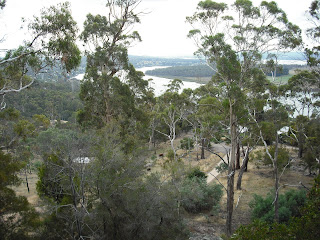

Being the story of our three week caravan trip around this lovely island, hoping to add Cornish content wherever and whenever we may find it. Other family history will also be included.










Just before St Mary's we saw a sign pointing to - CORNWALL! Yes! we thought, at last, some Cornish input for the blog. Only 3km up the road, we found the little village, which had been the site of a coal mine opened in 1886 (coal had been found in 1843, but it needed the railway to make it a viable business proposition). Some Cornish tin miners had been brought out to teach their mining skills, and the company formed was appropriately called the Cornwall Coal Mining Company. I couldn't find any further info about the tin miners, who they were and how many, or what happened to them .... but there is a Wall of remembrance with the names of many, many miners who had worked in the district. After the obligatory pictures had been taken we continued on to St Mary's, then through St Mary's Pass - shudder, steep drop on my side, be CAREFUL Max!!! On to the Tasman Hwy - we made St Helen's by lunch time, and had yummy fish and chips from The Captain's Catch - very nicely done, none of your greasies in St Helen's!
Next stop Bicheno - oh, we like Bicheno! It had clouded over by the time we got there, but the brisk breeze blowing at St Helen's had dropped right away, and it was very pleasant. A walk along the clifftop, admiring Diamond Island and the wonderful rock formations, and then we decided to look for a cray for tea - this was Bicheno, after all! We asked at the Visitor Centre - certainly we could buy a cray, over at the butchers of all places! It was a gourmet butcher admittedly, who specialised in sausages - Max pointed out the varieties listed, there must have been thirty at least! Half a cray cost us $54 and a dozen green prawns was another $12 - then I noticed the butcher made his own brawn, now I haven't seen brawn since my mother used to make it - so we had to have some of that! Well, it was an expensive tea, but it was worth it!
By this time it was about 3.30pm and we thought it was time to head for home - Ross was 100km away, taking the Lake Leake Road back to the Midland Hwy. The sun was shining on the midlands, and we remarked on the difference in the weather, presuming the mountains are the influence which make it so changeable.
 The famous Ross Bridge
The famous Ross Bridge

 The Salmon Ponds
The Salmon Ponds
 Port Arthur ruins
Port Arthur ruins
 Hobart in miniature - Government House on the left
Hobart in miniature - Government House on the left
 Richmond Bridge
Richmond Bridge
 Steve Cain at work
Steve Cain at work
 Left, bins of golden delicious apples waiting to be picked up
Left, bins of golden delicious apples waiting to be picked up

 Left: Hobart and the mountain from the Eastern Shore.
Left: Hobart and the mountain from the Eastern Shore.
 My friend the snake
My friend the snake

 The King River and the delta which has been created.
The King River and the delta which has been created.



 Approaching Hell's Gates on our Gordon River Cruise. So-named by the convicts who regarded Sarah Island as hell on earth. We were on a lighthearted tourist cruise, but others who came before us were not so lucky ....
Approaching Hell's Gates on our Gordon River Cruise. So-named by the convicts who regarded Sarah Island as hell on earth. We were on a lighthearted tourist cruise, but others who came before us were not so lucky .... The lighthouse at Hell's Gates. It was very sobering to imagine how the convicts felt as they passed these portals. Barely 70 metres wide, it opens up into huge Macquarie Harbour, wherein lies Sarah Island, penal settlement between 1822-1833, and designed as the last place of punishment for repeat offenders. It was abandoned in 1833 in favour of Port Arthur, a brand new hell on earth.
The lighthouse at Hell's Gates. It was very sobering to imagine how the convicts felt as they passed these portals. Barely 70 metres wide, it opens up into huge Macquarie Harbour, wherein lies Sarah Island, penal settlement between 1822-1833, and designed as the last place of punishment for repeat offenders. It was abandoned in 1833 in favour of Port Arthur, a brand new hell on earth. Infamous Sarah Island in 2009 -
Infamous Sarah Island in 2009 - Max enjoying a cappucino this afternoon.
Max enjoying a cappucino this afternoon.
 'The Eagle' the boat which will take us on a cruise of the Gordon River tomorrow (the one in the background, not the cray boat!)
'The Eagle' the boat which will take us on a cruise of the Gordon River tomorrow (the one in the background, not the cray boat!)
 Waratah then and now .... there are lots of buildings still in Waratah, but many of the old building have been pulled down.
Waratah then and now .... there are lots of buildings still in Waratah, but many of the old building have been pulled down.